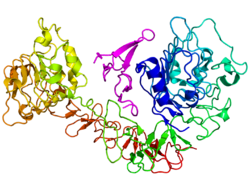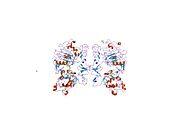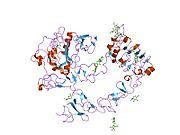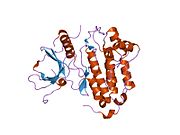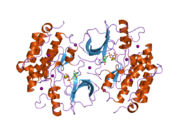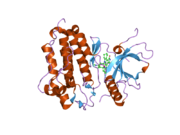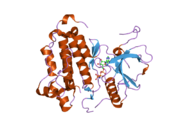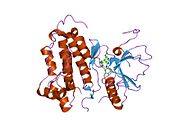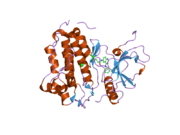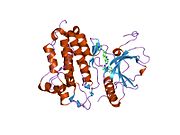Receptor epidermnog faktora rasta
Receptor epidermnog faktora rasta (EGFR, ErbB-1, HER1 kod ljudi je transmembranski protein, receptor za članove epidermnog faktora rasta porodice EGF vanćelijskog proteinskog liganda.[5]
Receptor epidermnog faktora rasta je član receptora porodice ErbB, potporodice od četiri blisko povezane receptorske tirozin-kinaze: EGFR (ErbB-1), HER2/neu (ErbB-2), 3 HER (ErbB-3) i HER-4 (ErbB-4). Kod mnogih tipova raka, mutacije koje utiču na ekspresiju ili aktivnost EGFR-a mogu dovesti do raka.[6]
Epidermni faktor rasta i njegov receptor otkrio je Stanley Cohen sa Vanderbilt University. Cohen je 1986. godine podijelio Nobelovu nagradu za fiziologiju ili medicinu sa Ritom Levi-Montalcini za njihovo otkriće faktora rasta.
Nedostatak signalizacije EGFR-a i drugih receptorska tirozin-kinaza kod ljudi povezan je s bolestima kao što je Alzheimerova bolest, dok je prekomjerna ekspresija povezana s razvojem širokog spektra tumora. Prekid EGFR signalizacije, bilo blokiranjem EGFR mjesta vezanja na vanćelijskom domenu receptora ili inhibicijom aktivnosti unutarćelijskih tirozin-kinaza, može spriječiti rast tumora koji eksprimiraju EGFR i poboljšati stanje pacijenta.
Aminokiselinska sekvenca
[uredi | uredi izvor]Dužina polipeptidnog lanca je 1.210 aminokiselina, a molekulska težina 134.277 Da.[6]
| 10 | 20 | 30 | 40 | 50 | ||||
|---|---|---|---|---|---|---|---|---|
| MRPSGTAGAA | LLALLAALCP | ASRALEEKKV | CQGTSNKLTQ | LGTFEDHFLS | ||||
| LQRMFNNCEV | VLGNLEITYV | QRNYDLSFLK | TIQEVAGYVL | IALNTVERIP | ||||
| LENLQIIRGN | MYYENSYALA | VLSNYDANKT | GLKELPMRNL | QEILHGAVRF | ||||
| SNNPALCNVE | SIQWRDIVSS | DFLSNMSMDF | QNHLGSCQKC | DPSCPNGSCW | ||||
| GAGEENCQKL | TKIICAQQCS | GRCRGKSPSD | CCHNQCAAGC | TGPRESDCLV | ||||
| CRKFRDEATC | KDTCPPLMLY | NPTTYQMDVN | PEGKYSFGAT | CVKKCPRNYV | ||||
| VTDHGSCVRA | CGADSYEMEE | DGVRKCKKCE | GPCRKVCNGI | GIGEFKDSLS | ||||
| INATNIKHFK | NCTSISGDLH | ILPVAFRGDS | FTHTPPLDPQ | ELDILKTVKE | ||||
| ITGFLLIQAW | PENRTDLHAF | ENLEIIRGRT | KQHGQFSLAV | VSLNITSLGL | ||||
| RSLKEISDGD | VIISGNKNLC | YANTINWKKL | FGTSGQKTKI | ISNRGENSCK | ||||
| ATGQVCHALC | SPEGCWGPEP | RDCVSCRNVS | RGRECVDKCN | LLEGEPREFV | ||||
| ENSECIQCHP | ECLPQAMNIT | CTGRGPDNCI | QCAHYIDGPH | CVKTCPAGVM | ||||
| GENNTLVWKY | ADAGHVCHLC | HPNCTYGCTG | PGLEGCPTNG | PKIPSIATGM | ||||
| VGALLLLLVV | ALGIGLFMRR | RHIVRKRTLR | RLLQERELVE | PLTPSGEAPN | ||||
| QALLRILKET | EFKKIKVLGS | GAFGTVYKGL | WIPEGEKVKI | PVAIKELREA | ||||
| TSPKANKEIL | DEAYVMASVD | NPHVCRLLGI | CLTSTVQLIT | QLMPFGCLLD | ||||
| YVREHKDNIG | SQYLLNWCVQ | IAKGMNYLED | RRLVHRDLAA | RNVLVKTPQH | ||||
| VKITDFGLAK | LLGAEEKEYH | AEGGKVPIKW | MALESILHRI | YTHQSDVWSY | ||||
| GVTVWELMTF | GSKPYDGIPA | SEISSILEKG | ERLPQPPICT | IDVYMIMVKC | ||||
| WMIDADSRPK | FRELIIEFSK | MARDPQRYLV | IQGDERMHLP | SPTDSNFYRA | ||||
| LMDEEDMDDV | VDADEYLIPQ | QGFFSSPSTS | RTPLLSSLSA | TSNNSTVACI | ||||
| DRNGLQSCPI | KEDSFLQRYS | SDPTGALTED | SIDDTFLPVP | EYINQSVPKR | ||||
| PAGSVQNPVY | HNQPLNPAPS | RDPHYQDPHS | TAVGNPEYLN | TVQPTCVNST | ||||
| FDSPAHWAQK | GSHQISLDNP | DYQQDFFPKE | AKPNGIFKGS | TAENAEYLRV | ||||
| APQSSEFIGA |
Funkcija
[uredi | uredi izvor]

Receptor epidermalnog faktora rasta (EGFR) je transmembranski protein koji se aktivira vezivanjem njegovih specifičnih liganda, uključujući epidermni faktor rasta i transformirajući faktor rasta α (TGFα). ErbB2 nema poznatu direktnu aktivaciju liganda i može biti u konstitutivnom aktiviranom stanju ili postati aktivan nakon heterodimerizacije sa drugim članovima porodice kao što je EGFR. Nakon aktivacije svojim ligandima faktora rasta, EGFR prolazi kroz tranziciju iz neaktivnog monomernog oblika u aktivni homodimer.[7] – although there is some evidence that preformed inactive dimers may also exist before ligand binding.[8] Pored formiranja homodimera nakon vezivanja liganda, EGFR se može upariti sa drugim članom porodice ErbB receptora, kao što je ErbB2/Her2/neu, kako bi se stvorio aktivirani heterodimer. Postoje i dokazi koji ukazuju na to da se formiraju klasteri aktiviranih EGFR-ova, iako ostaje nejasno da li je ovo grupiranje važno za samu aktivaciju ili se javlja nakon aktivacije pojedinačnih dimera.
Dimerizacija EGFR-a stimuliše njegovu unutarćelijsku aktivnost protein-tirozin kinaze. Kao rezultat, dolazi do autofosforilacije nekoliko tirozinskih (Y) ostataka na C-terminalnom domenu EGFR. To uključuje Y992, Y1045, Y1068, Y1148 i Y1173, kao što je prikazano na susjednom dijagramu.[9] Ova autofosforilacija izaziva nizvodnu aktivaciju i signalizaciju nekoliko drugih proteina koji se povezuju sa fosforiliranim tirozinima preko vlastitih fosfotirozin-vezujućih SH2-domena. Ovi nizvodni signalni proteini pokreću nekoliko kaskada transdukcija signala, uglavnom MAPK, Akt i JNK puteve, što dovodi do DNK sinteze i proliferacija ćelija.[10] Takvi proteini moduliraju fenotipove kao što su ćelijska migracija, adhezija i proliferacija. Aktivacija receptora je važna za urođeni imunski odgovor u ljudskoj koži. Domen kinaze EGFR-a također može unakrsno fosforilirati tirozinske ostatke drugih receptora s kojima je agregiran i može se sam aktivirati na taj način.
Biološke uloge
[uredi | uredi izvor]EGFR je neophodan za razvoj cjevastih mliječnih žlijezda,[11][12][13] i agonisti EGFR-a kao što su amfiregulin, TGF-α i heregulin induciraju i duktusni i lobuloalveolski razvoj, čak i u odsustvu estrogena i progesterona.[14][15]
Klinički značaj
[uredi | uredi izvor]Kancer
[uredi | uredi izvor]Mutacije koje dovode do prekomjerne ekspresije EGFR-a (poznate kao nadregulacija ili pojačanje) povezane su s brojnim karcinomima, uključujući adenokarcinom pluća (40% slučajeva), anusni rak,[16] glioblastom (50%) i epitelni tumori glave i vrata (80–100%).[17] Ove somatske mutacije koje uključuju EGFR dovode do njegove stalne aktivacije, što uzrokuje nekontrolirane diobe ćelija.[18] Kod glioblastoma se često opaža specifična mutacija EGFR, zvana EGFRvIII.[19] Mutacije, pojačanja ili pogrešna regulacija EGFR-a ili članova porodice su uključeni u oko 30% svih epitelnih karcinoma.[20]
Upalna bolest
[uredi | uredi izvor]Aberantna EGFR signalizacija je implicirana kod psorijaze, ekcema i ateroskleroze.[21][22] Međutim, njegove tačne uloge u ovim uslovima su loše definisane.
Monogenska bolest
[uredi | uredi izvor]Utvrđeno je da jedno dijete koje pokazuje upalu epitela više organa ima homozigotnu mutaciju gubitka funkcije u "EGFR" genu. Patogenost EGFR mutacije je potvrđena in vitro eksperimentima i funkcionalnom analizom biopsije kože. Njegov teški fenotip odražava mnoga ranija istraživanja funkcije EGFR. Njegove kliničke karakteristike su uključivale papulopustulni osip, suhu kožu, hroničnu dijareju, abnormalnosti rasta dlake, poteškoće s disanjem i neravnotežu elektrolita.[23]
Zacjeljivanje rana i fibroza
[uredi | uredi izvor]Pokazalo se da EGFR ima ključnu ulogu u diferencijaciji TGF beta 1, zavisnoj od fibroblasta do miofibroblasta.[24][25] Aberantna perzistencija miofibroblasta unutar tkiva može dovesti do progresivnog tkiva fibroze, oštećenja funkcije tkiva ili organa (npr. kože hipertrofični ili keloidni ožiljci, ciroza jetre, fibroza miokarda, hronična bolest bubrega).
Medicinska primjena
[uredi | uredi izvor]Meta lijekova
[uredi | uredi izvor]Identifikacija EGFR-a kao onkogena dovela je do razvoja antikancerogenih lijekova usmjerenih protiv EGFR-a (koji se nazivaju "EGFR inhibitori", EGFRi), uključujući gefitinib,[26] erlotinib, afatinib, brigatinib i ikotinib[27] za rak pluća i cetuksimab za rak debelog crijeva. Nedavno je AstraZeneca razvila Osimertinib, treću generaciju inhibitora tirozin-kinaze.[28]
Mnogi terapijski pristupi usmjereni su na EGFR. Cetuksimab i panitumumab su primjeri inhibitorskih monoklonska antitijela. Međutim, prvi je tipa IgG1, a drugi tipa IgG2; posljedice na ćelijsku citotoksičnost zavisnu od antitijela mogu biti sasvim različite.[29] Ostali monoklonski agensi u kliničkom razvoju su zalutumumab, nimotuzumab i matuzumab. Monoklonska antitijela blokiraju domen za vezivanje vanćelijskog liganda. Sa blokiranim mjestom vezivanja, signalne molekule se više ne mogu vezati tamo i aktivirati tirozin-kinazu.
Drugi metod je korištenje malih molekula za inhibiciju EGFR tirozin-kinaze, koja se nalazi na citoplazmatskoj strani receptora. Bez aktivnosti kinaze, EGFR nije u stanju da se aktivira, što je preduslov za vezivanje nizvodnih adapterskih proteina. Navodno zaustavljanjem signalne kaskade u ćelijama koje se oslanjaju na ovaj put za ćelijski rast, proliferacija i migracija tumora je smanjena. Gefitinib, erlotinib, brigatinib i lapatinib (mješoviti EGFR i ERBB2 inhibitor) su primjeri inhibitora malih molekula kinaze.
CimaVax-EGF, aktivna vakcina koja cilja EGF kao glavni ligand EGF-a, koristi drugačiji pristup, podižući antitijela protiv samog EGF-a, čime se poriču EGFR zavisni karcinomi proliferativni stimulus;[30] koristi se kao terapija raka protiv karcinoma nemalih ćelija pluća (najčešći oblik raka pluća) na Kubi, a prolazi dalje ispitivanje za moguće licenciranje u Japanu, Evropi i Sjedinjenim Državama.[31]
Postoji nekoliko dostupnih kvantitativnih metoda koje koriste detekciju fosforilacije proteina za identifikaciju inhibitora porodice EGFR.[32]
Novi lijekovi kao što su osimertinib, gefitinib, erlotinib i brigatinib direktno ciljaju EGFR. Pacijenti su podijeljeni na EGFR-pozitivne i EGFR-negativne, na osnovu toga da li test tkiva pokazuje mutaciju. EGFR-pozitivni pacijenti pokazali su stopu odgovora od 60%, što premašuje stopu odgovora za konvencionalnu hemoterapiju.[33]
Međutim, mnogi pacijenti razvijaju otpornost. Dva primarna izvora rezistencije su mutacija T790M i MET onkogen.[33] Međutim, od 2010. nije postojao konsenzus o prihvaćenom pristupu borbi protiv otpora niti odobrenje FDA za određenu kombinaciju. Rezultati kliničkog ispitivanja faze II prijavljeni za brigatinib koji cilja na mutaciju T790M, a brigatinib je dobio status probojne terapije kod FDA u februaru 2015. godine.
Najčešći štetni efekat EGFR inhibitora, koji se nalazi kod više od 90% pacijenata, je papulopustulni osip koji se širi preko lica i trupa; prisustvo osipa je u korelaciji sa antitumorskim dejstvom lijeka.[34] Kod 10% do 15% pacijenata efekti mogu biti ozbiljni i zahtijevaju liječenje.[35][36]
Neki testovi imaju za cilj predviđanje koristi od EGFR tretmana, kao što je Veristrat.[37]
Laboratorijsko istraživanje koje koristi genetički modifikovane matične ćelije za ciljanje EGFR kod miševa objavljeno je 2014. da obećava.[38] EGFR is a well-established target for monoclonal antibodies and specific tyrosine kinase inhibitors.[39]
Meta agenasa za snimanje
[uredi | uredi izvor]Razvijeni su agensi za snimanje koji identifikuju karcinome zavisne od EGFR, koristeći označeni EGF.[40] Izvodljivost snimanja ekspresije in vivo EGFR pokazano je u nekoliko studija.[41][42]
Predloženo je da određeni nalazi kompjuterizirane tomografije kao što su opaciteti brušenog stakla, zračni bronhogram, spikulirane ivice, vaskularna konvergencija i pleuralna retrakcija mogu predvidjeti prisustvo EGFR mutacije kod pacijenata s karcinomom pluća nemalih ćelija.[43]
Interakcije
[uredi | uredi izvor]Pokazalo se da receptor epidermalnog faktora rasta reaguje sa:
- AR,[44][45]
- ARF4,[46]
- CAV1,[47]
- CAV3,[47]
- CBL,[48][49][50][51][52]
- CBLB,[49][53]
- CBLC,[54][55]
- CD44,[24]
- CDC25A,[56]
- CRK,[53][57]
- CTNNB1,[58][59][60]
- DCN,[61][62]
- EGF,[63][64]
- GRB14,[65]
- Grb2,[53][63][65][66][67][68][69][70][71][72]
- JAK2,[73]
- MUC1,[74][75]
- NCK1,[66][76][77]
- NCK2[66][78][79]
- PKC-alfa,[80]
- PLCG1,[48][81]
- PLSCR1,[82]
- PTPN1,[83][84]
- PTPN11,[53][85]
- PTPN6,[85][86]
- PTPRK,[87]
- SH2D3A,[88]
- SH3KBP1,[89][90]
- SHC1,[53][91]
- SOS1,[71][92][93]
- Src,[73][94][95]
- STAT1,[73][96]
- STAT3,[73][97]
- STAT5A,[53][73]
- UBC,[50][51][98] i
- WAS,[99]
- PAR2.[100]
Kod voćnih mušica, receptor epidermnog faktora rasta stupa u interakciju sa Spic.[101]
Reference
[uredi | uredi izvor]- ^ a b c GRCh38: Ensembl release 89: ENSG00000146648 - Ensembl, maj 2017
- ^ a b c GRCm38: Ensembl release 89: ENSMUSG00000020122 - Ensembl, maj 2017
- ^ "Human PubMed Reference:". National Center for Biotechnology Information, U.S. National Library of Medicine.
- ^ "Mouse PubMed Reference:". National Center for Biotechnology Information, U.S. National Library of Medicine.
- ^ Herbst RS (2004). "Review of epidermal growth factor receptor biology". International Journal of Radiation Oncology, Biology, Physics. 59 (2 Suppl): 21–6. doi:10.1016/j.ijrobp.2003.11.041. PMID 15142631.
- ^ a b Zhang H, Berezov A, Wang Q, Zhang G, Drebin J, Murali R, Greene MI (august 2007). "ErbB receptors: from oncogenes to targeted cancer treatment". The Journal of Clinical Investigation. 117 (8): 2051–8. doi:10.1172/JCI32278. PMC 1934579. PMID 17671639.
- ^ Yarden Y, Schlessinger J (mart 1987). "Epidermal growth factor induces rapid, reversible aggregation of the purified epidermal growth factor receptor". Biochemistry. 26 (5): 1443–51. doi:10.1021/bi00379a035. PMID 3494473.
- ^ Maruyama IN (april 2014). "Mechanisms of activation of receptor tyrosine kinases: monomers or dimers". Cells. 3 (2): 304–30. doi:10.3390/cells3020304. PMC 4092861. PMID 24758840.
- ^ Downward J, Parker P, Waterfield MD (1984). "Autophosphorylation sites on the epidermal growth factor receptor". Nature. 311 (5985): 483–5. Bibcode:1984Natur.311..483D. doi:10.1038/311483a0. PMID 6090945. S2CID 4332354.
- ^ Oda K, Matsuoka Y, Funahashi A, Kitano H (2005). "A comprehensive pathway map of epidermal growth factor receptor signaling". Molecular Systems Biology. 1 (1): E1–E17. doi:10.1038/msb4100014. PMC 1681468. PMID 16729045.
- ^ Sebastian J, Richards RG, Walker MP, Wiesen JF, Werb Z, Derynck R, Hom YK, Cunha GR, DiAugustine RP (septembar 1998). "Activation and function of the epidermal growth factor receptor and erbB-2 during mammary gland morphogenesis". Cell Growth & Differentiation. 9 (9): 777–85. PMID 9751121.
- ^ McBryan J, Howlin J, Napoletano S, Martin F (juni 2008). "Amphiregulin: role in mammary gland development and breast cancer". Journal of Mammary Gland Biology and Neoplasia. 13 (2): 159–69. doi:10.1007/s10911-008-9075-7. PMID 18398673. S2CID 13229645.
- ^ Sternlicht MD, Sunnarborg SW (juni 2008). "The ADAM17-amphiregulin-EGFR axis in mammary development and cancer". Journal of Mammary Gland Biology and Neoplasia. 13 (2): 181–94. doi:10.1007/s10911-008-9084-6. PMC 2723838. PMID 18470483.
- ^ Kenney NJ, Bowman A, Korach KS, Barrett JC, Salomon DS (maj 2003). "Effect of exogenous epidermal-like growth factors on mammary gland development and differentiation in the estrogen receptor-alpha knockout (ERKO) mouse". Breast Cancer Research and Treatment. 79 (2): 161–73. doi:10.1023/a:1023938510508. PMID 12825851. S2CID 30782707.
- ^ Kenney NJ, Smith GH, Rosenberg K, Cutler ML, Dickson RB (decembar 1996). "Induction of ductal morphogenesis and lobular hyperplasia by amphiregulin in the mouse mammary gland". Cell Growth & Differentiation. 7 (12): 1769–81. PMID 8959346.
- ^ Walker F, Abramowitz L, Benabderrahmane D, Duval X, Descatoire V, Hénin D, et al. (novembar 2009). "Growth factor receptor expression in anal squamous lesions: modifications associated with oncogenic human papillomavirus and human immunodeficiency virus". Human Pathology. 40 (11): 1517–27. doi:10.1016/j.humpath.2009.05.010. PMID 19716155.
- ^ Kumar V, Abbas A, Aster J (2013). Robbins basic pathology. Philadelphia: Elsevier/Saunders. str. 179. ISBN 9781437717815.
- ^ Lynch TJ, Bell DW, Sordella R, Gurubhagavatula S, Okimoto RA, Brannigan BW, et al. (maj 2004). "Activating mutations in the epidermal growth factor receptor underlying responsiveness of non-small-cell lung cancer to gefitinib" (PDF). The New England Journal of Medicine. 350 (21): 2129–39. doi:10.1056/NEJMoa040938. PMID 15118073. Arhivirano s originala (PDF), 21. 7. 2018. Pristupljeno 12. 3. 2022.
- ^ Kuan CT, Wikstrand CJ, Bigner DD (juni 2001). "EGF mutant receptor vIII as a molecular target in cancer therapy". Endocrine-Related Cancer. 8 (2): 83–96. doi:10.1677/erc.0.0080083. PMID 11397666. S2CID 11790891.
- ^ Zhen Y, Guanghui L, Xiefu Z (novembar 2014). "Knockdown of EGFR inhibits growth and invasion of gastric cancer cells". Cancer Gene Therapy. 21 (11): 491–7. doi:10.1038/cgt.2014.55. PMID 25394504.
- ^ Jost M, Kari C, Rodeck U (2000). "The EGF receptor – an essential regulator of multiple epidermal functions". European Journal of Dermatology. 10 (7): 505–10. PMID 11056418.
- ^ Dreux AC, Lamb DJ, Modjtahedi H, Ferns GA (maj 2006). "The epidermal growth factor receptors and their family of ligands: their putative role in atherogenesis". Atherosclerosis. 186 (1): 38–53. doi:10.1016/j.atherosclerosis.2005.06.038. PMID 16076471.
- ^ Campbell P, Morton PE, Takeichi T, Salam A, Roberts N, Proudfoot LE, Mellerio JE, Aminu K, Wellington C, Patil SN, Akiyama M, Liu L, McMillan JR, Aristodemou S, Ishida-Yamamoto A, Abdul-Wahab A, Petrof G, Fong K, Harnchoowong S, Stone KL, Harper JI, McLean WH, Simpson MA, Parsons M, McGrath JA (oktobar 2014). "Epithelial inflammation resulting from an inherited loss-of-function mutation in EGFR". The Journal of Investigative Dermatology. 134 (10): 2570–8. doi:10.1038/jid.2014.164. PMC 4090136. PMID 24691054.
- ^ a b Midgley AC, Rogers M, Hallett MB, Clayton A, Bowen T, Phillips AO, Steadman R (maj 2013). "Transforming growth factor-β1 (TGF-β1)-stimulated fibroblast to myofibroblast differentiation is mediated by hyaluronan (HA)-facilitated epidermal growth factor receptor (EGFR) and CD44 co-localization in lipid rafts". The Journal of Biological Chemistry. 288 (21): 14824–38. doi:10.1074/jbc.M113.451336. PMC 3663506. PMID 23589287.
- ^ Midgley AC, Bowen T, Phillips AO, Steadman R (april 2014). "MicroRNA-7 inhibition rescues age-associated loss of epidermal growth factor receptor and hyaluronan-dependent differentiation in fibroblasts". Aging Cell. 13 (2): 235–44. doi:10.1111/acel.12167. PMC 4331777. PMID 24134702.
- ^ Paez JG, Jänne PA, Lee JC, Tracy S, Greulich H, Gabriel S, Herman P, Kaye FJ, Lindeman N, Boggon TJ, Naoki K, Sasaki H, Fujii Y, Eck MJ, Sellers WR, Johnson BE, Meyerson M (juni 2004). "EGFR mutations in lung cancer: correlation with clinical response to gefitinib therapy". Science. 304 (5676): 1497–500. Bibcode:2004Sci...304.1497P. doi:10.1126/science.1099314. PMID 15118125.
- ^ Liang W, Wu X, Fang W, Zhao Y, Yang Y, Hu Z, Xue C, Zhang J, Zhang J, Ma Y, Zhou T, Yan Y, Hou X, Qin T, Dinglin X, Tian Y, Huang P, Huang Y, Zhao H, Zhang L (12. 2. 2014). "Network meta-analysis of erlotinib, gefitinib, afatinib and icotinib in patients with advanced non-small-cell lung cancer harboring EGFR mutations". PLOS ONE. 9 (2): e85245. Bibcode:2014PLoSO...985245L. doi:10.1371/journal.pone.0085245. PMC 3922700. PMID 24533047.
- ^ Greig SL (februar 2016). "Osimertinib: First Global Approval". Drugs. 76 (2): 263–73. doi:10.1007/s40265-015-0533-4. PMID 26729184. S2CID 45076898.
- ^ Yan L, Beckman RA (oktobar 2005). "Pharmacogenetics and pharmacogenomics in oncology therapeutic antibody development". BioTechniques. 39 (4): 565–8. doi:10.2144/000112043. PMID 16235569.
- ^ Rodríguez PC, Rodríguez G, González G, Lage A (Winter 2010). "Clinical development and perspectives of CIMAvax EGF, Cuban vaccine for non-small-cell lung cancer therapy". MEDICC Review. 12 (1): 17–23. doi:10.37757/MR2010.V12.N1.4. PMID 20387330.
- ^ Patel N (11. 5. 2015). "Cuba Has a Lung Cancer Vaccine—And America Wants It". Wired. Pristupljeno 13. 5. 2015.
- ^ Olive DM (oktobar 2004). "Quantitative methods for the analysis of protein phosphorylation in drug development". Expert Review of Proteomics. 1 (3): 327–41. doi:10.1586/14789450.1.3.327. PMID 15966829. S2CID 30003827.
- ^ a b Jackman DM, Miller VA, Cioffredi LA, Yeap BY, Jänne PA, Riely GJ, Ruiz MG, Giaccone G, Sequist LV, Johnson BE (august 2009). "Impact of epidermal growth factor receptor and KRAS mutations on clinical outcomes in previously untreated non-small cell lung cancer patients: results of an online tumor registry of clinical trials". Clinical Cancer Research. 15 (16): 5267–73. doi:10.1158/1078-0432.CCR-09-0888. PMC 3219530. PMID 19671843.
- ^ Liu HB, Wu Y, Lv TF, Yao YW, Xiao YY, Yuan DM, Song Y (2013). "Skin rash could predict the response to EGFR tyrosine kinase inhibitor and the prognosis for patients with non-small cell lung cancer: a systematic review and meta-analysis". PLOS ONE. 8 (1): e55128. Bibcode:2013PLoSO...855128L. doi:10.1371/journal.pone.0055128. PMC 3559430. PMID 23383079.
- ^ Gerber PA, Meller S, Eames T, Buhren BA, Schrumpf H, Hetzer S, Ehmann LM, Budach W, Bölke E, Matuschek C, Wollenberg A, Homey B (2012). "Management of EGFR-inhibitor associated rash: a retrospective study in 49 patients". European Journal of Medical Research. 17 (1): 4. doi:10.1186/2047-783X-17-4. PMC 3351712. PMID 22472354.
- ^ Lacouture ME (oktobar 2006). "Mechanisms of cutaneous toxicities to EGFR inhibitors". Nature Reviews. Cancer. 6 (10): 803–12. doi:10.1038/nrc1970. PMID 16990857. S2CID 7782594.
- ^ Molina-Pinelo S, Pastor MD, Paz-Ares L (februar 2014). "VeriStrat: a prognostic and/or predictive biomarker for advanced lung cancer patients?". Expert Review of Respiratory Medicine. 8 (1): 1–4. doi:10.1586/17476348.2014.861744. PMID 24308656. S2CID 44854672.
- ^ Stuckey DW, Hingtgen SD, Karakas N, Rich BE, Shah K (februar 2015). "Engineering toxin-resistant therapeutic stem cells to treat brain tumors". Stem Cells. 33 (2): 589–600. doi:10.1002/stem.1874. PMC 4305025. PMID 25346520.
- ^ Roskoski R Jr (2014). "The ErbB/HER family of protein-tyrosine kinases and cancer". Pharmacol Res. 79: 34–74. doi:10.1016/j.phrs.2013.11.002. PMID 24269963.
- ^ Lucas LJ, Tellez CA, Castilho ML, Lee CL, Hupman MA, Vieira LS, Ferreira I, Raniero L, Hewitt KC (maj 2015). "Development of a sensitive, stable and EGFR-specific molecular imaging agent for surface enhanced Raman spectroscopy". Journal of Raman Spectroscopy. 46 (5): 434–446. Bibcode:2015JRSp...46..434L. doi:10.1002/jrs.4678.
- ^ Lucas LJ, Chen XK, Smith AJ, Korbelik M, Zeng, Haitian L, Lee PW, Hewitt KC (23. 1. 2015). "Aggregation of nanoparticles in endosomes and lysosomes produces surface-enhanced Raman spectroscopy". Journal of Nanophotonics. 9 (1): 093094–1–14. Bibcode:2015JNano...9.3094L. doi:10.1117/1.JNP.9.093094.
- ^ Andersson KG, Oroujeni M, Garousi J, Mitran B, Ståhl S, Orlova A, Löfblom J, Tolmachev V (decembar 2016). "Feasibility of imaging of epidermal growth factor receptor expression with ZEGFR:2377 affibody molecule labeled with 99mTc using a peptide-based cysteine-containing chelator". International Journal of Oncology. 49 (6): 2285–2293. doi:10.3892/ijo.2016.3721. PMC 5118000. PMID 27748899.
- ^ Herrera Ortiz AF, Cadavid Camacho T, Vásquez Perdomo A, Castillo Herazo V, Arambula Neira J, Yepes Bustamante M, Cadavid Camacho E. Clinical and CT patterns to predict EGFR mutation in patients with non-small cell lung cancer: A systematic literature review and meta-analysis. European Journal of Radiology Open.2022;9:100400. https://doi.org/10.1016/j.ejro.2022.100400
- ^ Bonaccorsi L, Carloni V, Muratori M, Formigli L, Zecchi S, Forti G, Baldi E (oktobar 2004). "EGF receptor (EGFR) signaling promoting invasion is disrupted in androgen-sensitive prostate cancer cells by an interaction between EGFR and androgen receptor (AR)". International Journal of Cancer. 112 (1): 78–86. doi:10.1002/ijc.20362. hdl:2158/395766. PMID 15305378. S2CID 46121331.
- ^ Bonaccorsi L, Muratori M, Carloni V, Marchiani S, Formigli L, Forti G, Baldi E (august 2004). "The androgen receptor associates with the epidermal growth factor receptor in androgen-sensitive prostate cancer cells". Steroids. 69 (8–9): 549–52. doi:10.1016/j.steroids.2004.05.011. hdl:2158/395763. PMID 15288768. S2CID 23831527.
- ^ Kim SW, Hayashi M, Lo JF, Yang Y, Yoo JS, Lee JD (januar 2003). "ADP-ribosylation factor 4 small GTPase mediates epidermal growth factor receptor-dependent phospholipase D2 activation". The Journal of Biological Chemistry. 278 (4): 2661–8. doi:10.1074/jbc.M205819200. PMID 12446727.
- ^ a b Couet J, Sargiacomo M, Lisanti MP (novembar 1997). "Interaction of a receptor tyrosine kinase, EGF-R, with caveolins. Caveolin binding negatively regulates tyrosine and serine/threonine kinase activities". The Journal of Biological Chemistry. 272 (48): 30429–38. doi:10.1074/jbc.272.48.30429. PMID 9374534.
- ^ a b Tvorogov D, Carpenter G (juli 2002). "EGF-dependent association of phospholipase C-gamma1 with c-Cbl". Experimental Cell Research. 277 (1): 86–94. doi:10.1006/excr.2002.5545. PMID 12061819.
- ^ a b Ettenberg SA, Keane MM, Nau MM, Frankel M, Wang LM, Pierce JH, Lipkowitz S (mart 1999). "cbl-b inhibits epidermal growth factor receptor signaling". Oncogene. 18 (10): 1855–66. doi:10.1038/sj.onc.1202499. PMID 10086340.
- ^ a b Pennock S, Wang Z (maj 2008). "A tale of two Cbls: interplay of c-Cbl and Cbl-b in epidermal growth factor receptor downregulation". Molecular and Cellular Biology. 28 (9): 3020–37. doi:10.1128/MCB.01809-07. PMC 2293090. PMID 18316398.
- ^ a b Umebayashi K, Stenmark H, Yoshimori T (august 2008). "Ubc4/5 and c-Cbl continue to ubiquitinate EGF receptor after internalization to facilitate polyubiquitination and degradation". Molecular Biology of the Cell. 19 (8): 3454–62. doi:10.1091/mbc.E07-10-0988. PMC 2488299. PMID 18508924.
- ^ Ng C, Jackson RA, Buschdorf JP, Sun Q, Guy GR, Sivaraman J (mart 2008). "Structural basis for a novel intrapeptidyl H-bond and reverse binding of c-Cbl-TKB domain substrates". The EMBO Journal. 27 (5): 804–16. doi:10.1038/emboj.2008.18. PMC 2265755. PMID 18273061.
- ^ a b c d e f Schulze WX, Deng L, Mann M (2005). "Phosphotyrosine interactome of the ErbB-receptor kinase family". Molecular Systems Biology. 1 (1): E1–E13. doi:10.1038/msb4100012. PMC 1681463. PMID 16729043.
- ^ Kim M, Tezuka T, Suziki Y, Sugano S, Hirai M, Yamamoto T (oktobar 1999). "Molecular cloning and characterization of a novel cbl-family gene, cbl-c". Gene. 239 (1): 145–54. doi:10.1016/S0378-1119(99)00356-X. PMID 10571044.
- ^ Keane MM, Ettenberg SA, Nau MM, Banerjee P, Cuello M, Penninger J, Lipkowitz S (juni 1999). "cbl-3: a new mammalian cbl family protein". Oncogene. 18 (22): 3365–75. doi:10.1038/sj.onc.1202753. PMID 10362357.
- ^ Wang Z, Wang M, Lazo JS, Carr BI (maj 2002). "Identification of epidermal growth factor receptor as a target of Cdc25A protein phosphatase". The Journal of Biological Chemistry. 277 (22): 19470–5. doi:10.1074/jbc.M201097200. PMID 11912208.
- ^ Hashimoto Y, Katayama H, Kiyokawa E, Ota S, Kurata T, Gotoh N, Otsuka N, Shibata M, Matsuda M (juli 1998). "Phosphorylation of CrkII adaptor protein at tyrosine 221 by epidermal growth factor receptor". The Journal of Biological Chemistry. 273 (27): 17186–91. doi:10.1074/jbc.273.27.17186. PMID 9642287.
- ^ Hazan RB, Norton L (april 1998). "The epidermal growth factor receptor modulates the interaction of E-cadherin with the actin cytoskeleton". The Journal of Biological Chemistry. 273 (15): 9078–84. doi:10.1074/jbc.273.15.9078. PMID 9535896.
- ^ Schroeder JA, Adriance MC, McConnell EJ, Thompson MC, Pockaj B, Gendler SJ (juni 2002). "ErbB-beta-catenin complexes are associated with human infiltrating ductal breast and murine mammary tumor virus (MMTV)-Wnt-1 and MMTV-c-Neu transgenic carcinomas". The Journal of Biological Chemistry. 277 (25): 22692–8. doi:10.1074/jbc.M201975200. PMID 11950845.
- ^ Takahashi K, Suzuki K, Tsukatani Y (juli 1997). "Induction of tyrosine phosphorylation and association of beta-catenin with EGF receptor upon tryptic digestion of quiescent cells at confluence". Oncogene. 15 (1): 71–8. doi:10.1038/sj.onc.1201160. PMID 9233779.
- ^ Santra M, Reed CC, Iozzo RV (septembar 2002). "Decorin binds to a narrow region of the epidermal growth factor (EGF) receptor, partially overlapping but distinct from the EGF-binding epitope". The Journal of Biological Chemistry. 277 (38): 35671–81. doi:10.1074/jbc.M205317200. PMID 12105206.
- ^ Iozzo RV, Moscatello DK, McQuillan DJ, Eichstetter I (februar 1999). "Decorin is a biological ligand for the epidermal growth factor receptor". The Journal of Biological Chemistry. 274 (8): 4489–92. doi:10.1074/jbc.274.8.4489. PMID 9988678.
- ^ a b Wong L, Deb TB, Thompson SA, Wells A, Johnson GR (mart 1999). "A differential requirement for the COOH-terminal region of the epidermal growth factor (EGF) receptor in amphiregulin and EGF mitogenic signaling". The Journal of Biological Chemistry. 274 (13): 8900–9. doi:10.1074/jbc.274.13.8900. PMID 10085134.
- ^ Stortelers C, Souriau C, van Liempt E, van de Poll ML, van Zoelen EJ (juli 2002). "Role of the N-terminus of epidermal growth factor in ErbB-2/ErbB-3 binding studied by phage display". Biochemistry. 41 (27): 8732–41. doi:10.1021/bi025878c. PMID 12093292.
- ^ a b Daly RJ, Sanderson GM, Janes PW, Sutherland RL (maj 1996). "Cloning and characterization of GRB14, a novel member of the GRB7 gene family". The Journal of Biological Chemistry. 271 (21): 12502–10. doi:10.1074/jbc.271.21.12502. PMID 8647858.
- ^ a b c Braverman LE, Quilliam LA (februar 1999). "Identification of Grb4/Nckbeta, a src homology 2 and 3 domain-containing adapter protein having similar binding and biological properties to Nck". The Journal of Biological Chemistry. 274 (9): 5542–9. doi:10.1074/jbc.274.9.5542. PMID 10026169.
- ^ Blagoev B, Kratchmarova I, Ong SE, Nielsen M, Foster LJ, Mann M (mart 2003). "A proteomics strategy to elucidate functional protein-protein interactions applied to EGF signaling". Nature Biotechnology. 21 (3): 315–8. doi:10.1038/nbt790. PMID 12577067. S2CID 26838266.
- ^ Oneyama C, Nakano H, Sharma SV (mart 2002). "UCS15A, a novel small molecule, SH3 domain-mediated protein-protein interaction blocking drug". Oncogene. 21 (13): 2037–50. doi:10.1038/sj.onc.1205271. PMID 11960376.
- ^ Okutani T, Okabayashi Y, Kido Y, Sugimoto Y, Sakaguchi K, Matuoka K, Takenawa T, Kasuga M (decembar 1994). "Grb2/Ash binds directly to tyrosines 1068 and 1086 and indirectly to tyrosine 1148 of activated human epidermal growth factor receptors in intact cells". The Journal of Biological Chemistry. 269 (49): 31310–4. doi:10.1016/S0021-9258(18)47424-8. PMID 7527043.
- ^ Tortora G, Damiano V, Bianco C, Baldassarre G, Bianco AR, Lanfrancone L, Pelicci PG, Ciardiello F (februar 1997). "The RIalpha subunit of protein kinase A (PKA) binds to Grb2 and allows PKA interaction with the activated EGF-receptor". Oncogene. 14 (8): 923–8. doi:10.1038/sj.onc.1200906. PMID 9050991.
- ^ a b Buday L, Egan SE, Rodriguez Viciana P, Cantrell DA, Downward J (mart 1994). "A complex of Grb2 adaptor protein, Sos exchange factor, and a 36-kDa membrane-bound tyrosine phosphoprotein is implicated in ras activation in T cells". The Journal of Biological Chemistry. 269 (12): 9019–23. doi:10.1016/S0021-9258(17)37070-9. PMID 7510700.
- ^ Lowenstein EJ, Daly RJ, Batzer AG, Li W, Margolis B, Lammers R, Ullrich A, Skolnik EY, Bar-Sagi D, Schlessinger J (august 1992). "The SH2 and SH3 domain-containing protein GRB2 links receptor tyrosine kinases to ras signaling". Cell. 70 (3): 431–42. doi:10.1016/0092-8674(92)90167-B. PMID 1322798.
- ^ a b c d e Olayioye MA, Beuvink I, Horsch K, Daly JM, Hynes NE (juni 1999). "ErbB receptor-induced activation of stat transcription factors is mediated by Src tyrosine kinases". The Journal of Biological Chemistry. 274 (24): 17209–18. doi:10.1074/jbc.274.24.17209. PMID 10358079.
- ^ Schroeder JA, Thompson MC, Gardner MM, Gendler SJ (april 2001). "Transgenic MUC1 interacts with epidermal growth factor receptor and correlates with mitogen-activated protein kinase activation in the mouse mammary gland". The Journal of Biological Chemistry. 276 (16): 13057–64. doi:10.1074/jbc.M011248200. PMID 11278868.
- ^ Li Y, Ren J, Yu W, Li Q, Kuwahara H, Yin L, Carraway KL, Kufe D (septembar 2001). "The epidermal growth factor receptor regulates interaction of the human DF3/MUC1 carcinoma antigen with c-Src and beta-catenin". The Journal of Biological Chemistry. 276 (38): 35239–42. doi:10.1074/jbc.C100359200. PMID 11483589.
- ^ Tang J, Feng GS, Li W (oktobar 1997). "Induced direct binding of the adapter protein Nck to the GTPase-activating protein-associated protein p62 by epidermal growth factor". Oncogene. 15 (15): 1823–32. doi:10.1038/sj.onc.1201351. PMID 9362449.
- ^ Li W, Hu P, Skolnik EY, Ullrich A, Schlessinger J (decembar 1992). "The SH2 and SH3 domain-containing Nck protein is oncogenic and a common target for phosphorylation by different surface receptors". Molecular and Cellular Biology. 12 (12): 5824–33. doi:10.1128/MCB.12.12.5824. PMC 360522. PMID 1333047.
- ^ Chen M, She H, Davis EM, Spicer CM, Kim L, Ren R, Le Beau MM, Li W (septembar 1998). "Identification of Nck family genes, chromosomal localization, expression, and signaling specificity". The Journal of Biological Chemistry. 273 (39): 25171–8. doi:10.1074/jbc.273.39.25171. PMID 9737977.
- ^ Tu Y, Li F, Wu C (decembar 1998). "Nck-2, a novel Src homology2/3-containing adaptor protein that interacts with the LIM-only protein PINCH and components of growth factor receptor kinase-signaling pathways". Molecular Biology of the Cell. 9 (12): 3367–82. doi:10.1091/mbc.9.12.3367. PMC 25640. PMID 9843575.
- ^ Gauthier ML, Torretto C, Ly J, Francescutti V, O'Day DH (august 2003). "Protein kinase Calpha negatively regulates cell spreading and motility in MDA-MB-231 human breast cancer cells downstream of epidermal growth factor receptor". Biochemical and Biophysical Research Communications. 307 (4): 839–46. doi:10.1016/S0006-291X(03)01273-7. PMID 12878187.
- ^ Bedrin MS, Abolafia CM, Thompson JF (juli 1997). "Cytoskeletal association of epidermal growth factor receptor and associated signaling proteins is regulated by cell density in IEC-6 intestinal cells". Journal of Cellular Physiology. 172 (1): 126–36. doi:10.1002/(SICI)1097-4652(199707)172:1<126::AID-JCP14>3.0.CO;2-A. PMID 9207933.
- ^ Sun J, Nanjundan M, Pike LJ, Wiedmer T, Sims PJ (maj 2002). "Plasma membrane phospholipid scramblase 1 is enriched in lipid rafts and interacts with the epidermal growth factor receptor". Biochemistry. 41 (20): 6338–45. doi:10.1021/bi025610l. PMID 12009895.
- ^ Sarmiento M, Puius YA, Vetter SW, Keng YF, Wu L, Zhao Y, Lawrence DS, Almo SC, Zhang ZY (juli 2000). "Structural basis of plasticity in protein tyrosine phosphatase 1B substrate recognition". Biochemistry. 39 (28): 8171–9. doi:10.1021/bi000319w. PMID 10889023.
- ^ Zhang ZY, Walsh AB, Wu L, McNamara DJ, Dobrusin EM, Miller WT (mart 1996). "Determinants of substrate recognition in the protein-tyrosine phosphatase, PTP1". The Journal of Biological Chemistry. 271 (10): 5386–92. doi:10.1074/jbc.271.10.5386. PMID 8621392.
- ^ a b Tomic S, Greiser U, Lammers R, Kharitonenkov A, Imyanitov E, Ullrich A, Böhmer FD (septembar 1995). "Association of SH2 domain protein tyrosine phosphatases with the epidermal growth factor receptor in human tumor cells. Phosphatidic acid activates receptor dephosphorylation by PTP1C". The Journal of Biological Chemistry. 270 (36): 21277–84. doi:10.1074/jbc.270.36.21277. PMID 7673163.
- ^ Keilhack H, Tenev T, Nyakatura E, Godovac-Zimmermann J, Nielsen L, Seedorf K, Böhmer FD (septembar 1998). "Phosphotyrosine 1173 mediates binding of the protein-tyrosine phosphatase SHP-1 to the epidermal growth factor receptor and attenuation of receptor signaling". The Journal of Biological Chemistry. 273 (38): 24839–46. doi:10.1074/jbc.273.38.24839. PMID 9733788.
- ^ Wang SE, Wu FY, Shin I, Qu S, Arteaga CL (juni 2005). "Transforming growth factor {beta} (TGF-{beta})-Smad target gene protein tyrosine phosphatase receptor type kappa is required for TGF-{beta} function". Molecular and Cellular Biology. 25 (11): 4703–15. doi:10.1128/MCB.25.11.4703-4715.2005. PMC 1140650. PMID 15899872.
- ^ Lu Y, Brush J, Stewart TA (april 1999). "NSP1 defines a novel family of adaptor proteins linking integrin and tyrosine kinase receptors to the c-Jun N-terminal kinase/stress-activated protein kinase signaling pathway". The Journal of Biological Chemistry. 274 (15): 10047–52. doi:10.1074/jbc.274.15.10047. PMID 10187783.
- ^ Soubeyran P, Kowanetz K, Szymkiewicz I, Langdon WY, Dikic I (mart 2002). "Cbl-CIN85-endophilin complex mediates ligand-induced downregulation of EGF receptors". Nature. 416 (6877): 183–7. Bibcode:2002Natur.416..183S. doi:10.1038/416183a. PMID 11894095. S2CID 635702.
- ^ Szymkiewicz I, Kowanetz K, Soubeyran P, Dinarina A, Lipkowitz S, Dikic I (oktobar 2002). "CIN85 participates in Cbl-b-mediated down-regulation of receptor tyrosine kinases". The Journal of Biological Chemistry. 277 (42): 39666–72. doi:10.1074/jbc.M205535200. PMID 12177062.
- ^ Sakaguchi K, Okabayashi Y, Kido Y, Kimura S, Matsumura Y, Inushima K, Kasuga M (april 1998). "Shc phosphotyrosine-binding domain dominantly interacts with epidermal growth factor receptors and mediates Ras activation in intact cells". Molecular Endocrinology. 12 (4): 536–43. doi:10.1210/me.12.4.536. PMID 9544989.
- ^ Qian X, Esteban L, Vass WC, Upadhyaya C, Papageorge AG, Yienger K, Ward JM, Lowy DR, Santos E (februar 2000). "The Sos1 and Sos2 Ras-specific exchange factors: differences in placental expression and signaling properties". The EMBO Journal. 19 (4): 642–54. doi:10.1093/emboj/19.4.642. PMC 305602. PMID 10675333.
- ^ Qian X, Vass WC, Papageorge AG, Anborgh PH, Lowy DR (februar 1998). "N terminus of Sos1 Ras exchange factor: critical roles for the Dbl and pleckstrin homology domains". Molecular and Cellular Biology. 18 (2): 771–8. doi:10.1128/mcb.18.2.771. PMC 108788. PMID 9447973.
- ^ Keely SJ, Calandrella SO, Barrett KE (april 2000). "Carbachol-stimulated transactivation of epidermal growth factor receptor and mitogen-activated protein kinase in T(84) cells is mediated by intracellular Ca2+, PYK-2, and p60(src)". The Journal of Biological Chemistry. 275 (17): 12619–25. doi:10.1074/jbc.275.17.12619. PMID 10777553.
- ^ Sato K, Kimoto M, Kakumoto M, Horiuchi D, Iwasaki T, Tokmakov AA, Fukami Y (septembar 2000). "Adaptor protein Shc undergoes translocation and mediates up-regulation of the tyrosine kinase c-Src in EGF-stimulated A431 cells". Genes to Cells. 5 (9): 749–64. doi:10.1046/j.1365-2443.2000.00358.x. PMID 10971656. S2CID 26366427.
- ^ Xia L, Wang L, Chung AS, Ivanov SS, Ling MY, Dragoi AM, Platt A, Gilmer TM, Fu XY, Chin YE (august 2002). "Identification of both positive and negative domains within the epidermal growth factor receptor COOH-terminal region for signal transducer and activator of transcription (STAT) activation". The Journal of Biological Chemistry. 277 (34): 30716–23. doi:10.1074/jbc.M202823200. PMID 12070153.
- ^ Yuan ZL, Guan YJ, Wang L, Wei W, Kane AB, Chin YE (novembar 2004). "Central role of the threonine residue within the p+1 loop of receptor tyrosine kinase in STAT3 constitutive phosphorylation in metastatic cancer cells". Molecular and Cellular Biology. 24 (21): 9390–400. doi:10.1128/MCB.24.21.9390-9400.2004. PMC 522220. PMID 15485908.
- ^ Sehat B, Andersson S, Girnita L, Larsson O (juli 2008). "Identification of c-Cbl as a new ligase for insulin-like growth factor-I receptor with distinct roles from Mdm2 in receptor ubiquitination and endocytosis". Cancer Research. 68 (14): 5669–77. doi:10.1158/0008-5472.CAN-07-6364. PMID 18632619.
- ^ She HY, Rockow S, Tang J, Nishimura R, Skolnik EY, Chen M, Margolis B, Li W (septembar 1997). "Wiskott-Aldrich syndrome protein is associated with the adapter protein Grb2 and the epidermal growth factor receptor in living cells". Molecular Biology of the Cell. 8 (9): 1709–21. doi:10.1091/mbc.8.9.1709. PMC 305731. PMID 9307968.
- ^ Jiang Y, Lim J, Wu KC, Xu W, Suen JY, Fairlie DP (novembar 2020). "PAR2 induces ovarian cancer cell motility by merging three signalling pathways to transactivate EGFR". British Journal of Pharmacology. (n/a) ((n/a)): 913–932. doi:10.1111/bph.15332. ISSN 0007-1188. PMID 33226635. S2CID 227135487.
- ^ Shilo BZ (mart 2003). "Signaling by the Drosophila epidermal growth factor receptor pathway during development". Experimental Cell Research. 284 (1): 140–9. doi:10.1016/S0014-4827(02)00094-0. PMID 12648473.
Dopunska literatura
[uredi | uredi izvor]- Carpenter G (1987). "Receptors for epidermal growth factor and other polypeptide mitogens". Annual Review of Biochemistry. 56 (1): 881–914. doi:10.1146/annurev.bi.56.070187.004313. PMID 3039909.
- Boonstra J, Rijken P, Humbel B, Cremers F, Verkleij A, van Bergen en Henegouwen P (maj 1995). "The epidermal growth factor". Cell Biology International. 19 (5): 413–30. doi:10.1006/cbir.1995.1086. PMID 7640657. S2CID 20186286.
- Carpenter G (august 2000). "The EGF receptor: a nexus for trafficking and signaling". BioEssays. 22 (8): 697–707. doi:10.1002/1521-1878(200008)22:8<697::AID-BIES3>3.0.CO;2-1. PMID 10918300.
- Filardo EJ (februar 2002). "Epidermal growth factor receptor (EGFR) transactivation by estrogen via the G-protein-coupled receptor, GPR30: a novel signaling pathway with potential significance for breast cancer". The Journal of Steroid Biochemistry and Molecular Biology. 80 (2): 231–8. doi:10.1016/S0960-0760(01)00190-X. PMID 11897506. S2CID 34995614.
- Tiganis T (januar 2002). "Protein tyrosine phosphatases: dephosphorylating the epidermal growth factor receptor". IUBMB Life. 53 (1): 3–14. doi:10.1080/15216540210811. PMID 12018405. S2CID 8376444.
- Di Fiore PP, Scita G (oktobar 2002). "Eps8 in the midst of GTPases". The International Journal of Biochemistry & Cell Biology. 34 (10): 1178–83. doi:10.1016/S1357-2725(02)00064-X. PMID 12127568.
- Benaim G, Villalobo A (august 2002). "Phosphorylation of calmodulin. Functional implications" (PDF). European Journal of Biochemistry. 269 (15): 3619–31. doi:10.1046/j.1432-1033.2002.03038.x. hdl:10261/79981. PMID 12153558.
- Leu TH, Maa MC (januar 2003). "Functional implication of the interaction between EGF receptor and c-Src". Frontiers in Bioscience. 8 (1–3): s28–38. doi:10.2741/980. PMID 12456372. S2CID 20827945.
- Anderson NL, Anderson NG (novembar 2002). "The human plasma proteome: history, character, and diagnostic prospects". Molecular & Cellular Proteomics. 1 (11): 845–67. doi:10.1074/mcp.R200007-MCP200. PMID 12488461.
- Kari C, Chan TO, Rocha de Quadros M, Rodeck U (januar 2003). "Targeting the epidermal growth factor receptor in cancer: apoptosis takes center stage". Cancer Research. 63 (1): 1–5. PMID 12517767.
- Bonaccorsi L, Muratori M, Carloni V, Zecchi S, Formigli L, Forti G, Baldi E (februar 2003). "Androgen receptor and prostate cancer invasion". International Journal of Andrology. 26 (1): 21–5. doi:10.1046/j.1365-2605.2003.00375.x. hdl:2158/252370. PMID 12534934.
- Reiter J, Maihle NJ (maj 2003). "Characterization and expression of novel 60-kDa and 110-kDa EGFR isoforms in human placenta". Annals of the New York Academy of Sciences. 995 (1): 39–47. Bibcode:2003NYASA.995...39R. doi:10.1111/j.1749-6632.2003.tb03208.x. PMID 12814937. S2CID 9377682.
- Adams TE, McKern NM, Ward CW (juni 2004). "Signalling by the type 1 insulin-like growth factor receptor: interplay with the epidermal growth factor receptor". Growth Factors. 22 (2): 89–95. doi:10.1080/08977190410001700998. PMID 15253384. S2CID 86844427.
- Ferguson KM (novembar 2004). "Active and inactive conformations of the epidermal growth factor receptor". Biochemical Society Transactions. 32 (Pt 5): 742–5. doi:10.1042/BST0320742. PMID 15494003.
- Chao C, Hellmich MR (decembar 2004). "Bi-directional signaling between gastrointestinal peptide hormone receptors and epidermal growth factor receptor". Growth Factors. 22 (4): 261–8. doi:10.1080/08977190412331286900. PMID 15621729. S2CID 35208079.
- Carlsson J, Ren ZP, Wester K, Sundberg AL, Heldin NE, Hesselager G, Persson M, Gedda L, Tolmachev V, Lundqvist H, Blomquist E, Nistér M (mart 2006). "Planning for intracavitary anti-EGFR radionuclide therapy of gliomas. Literature review and data on EGFR expression". Journal of Neuro-Oncology. 77 (1): 33–45. doi:10.1007/s11060-005-7410-z. PMID 16200342. S2CID 42293693.
- Scartozzi M, Pierantoni C, Berardi R, Antognoli S, Bearzi I, Cascinu S (april 2006). "Epidermal growth factor receptor: a promising therapeutic target for colorectal cancer". Analytical and Quantitative Cytology and Histology. 28 (2): 61–8. PMID 16637508.
- Prudkin L, Wistuba II (oktobar 2006). "Epidermal growth factor receptor abnormalities in lung cancer. Pathogenetic and clinical implications". Annals of Diagnostic Pathology. 10 (5): 306–15. doi:10.1016/j.anndiagpath.2006.06.011. PMID 16979526.
- Ahmed SM, Salgia R (novembar 2006). "Epidermal growth factor receptor mutations and susceptibility to targeted therapy in lung cancer". Respirology. 11 (6): 687–92. doi:10.1111/j.1440-1843.2006.00887.x. PMID 17052295. S2CID 38429131.
- Zhang X, Chang A (mart 2007). "Somatic mutations of the epidermal growth factor receptor and non-small-cell lung cancer". Journal of Medical Genetics. 44 (3): 166–72. doi:10.1136/jmg.2006.046102. PMC 2598028. PMID 17158592.
- Mellinghoff IK, Cloughesy TF, Mischel PS (januar 2007). "PTEN-mediated resistance to epidermal growth factor receptor kinase inhibitors". Clinical Cancer Research. 13 (2 Pt 1): 378–81. doi:10.1158/1078-0432.CCR-06-1992. PMID 17255257.
- Nakamura JL (april 2007). "The epidermal growth factor receptor in malignant gliomas: pathogenesis and therapeutic implications". Expert Opinion on Therapeutic Targets. 11 (4): 463–72. doi:10.1517/14728222.11.4.463. PMID 17373877. S2CID 21947310.
Vanjski linkovi
[uredi | uredi izvor]- Epidermal Growth Factor Receptor na US National Library of Medicine Medical Subject Headings (MeSH)
- P00533

